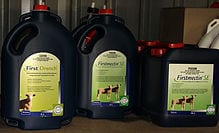Dr. Ray Kaplan, Professor of Parasitology, College of Veterinary Medicine, University of Georgia
(Previously published on American Consortium for Small Ruminant Parasite Control, January 2017)
There now is very strong evidence that using combination treatment is the best method for using de-wormers and should be instituted on all farms immediately.
Resistance to de-wormers is a fact of life, and the situation has worsened greatly in recent years. Surveys indicate that most farms have worms resistant to at least two of the three major groups of de-wormers. Many have resistance to all three groups, and some farms now have resistance to all available de-wormers. But, having worms in your animals that are resistant to de-wormers does not mean that all the worms are resistant. For instance, when all the commonly used de-wormers were first introduced, their efficacy was > 99%. Once efficacy falls below Continue reading Combination De-wormers: The Time is Now










